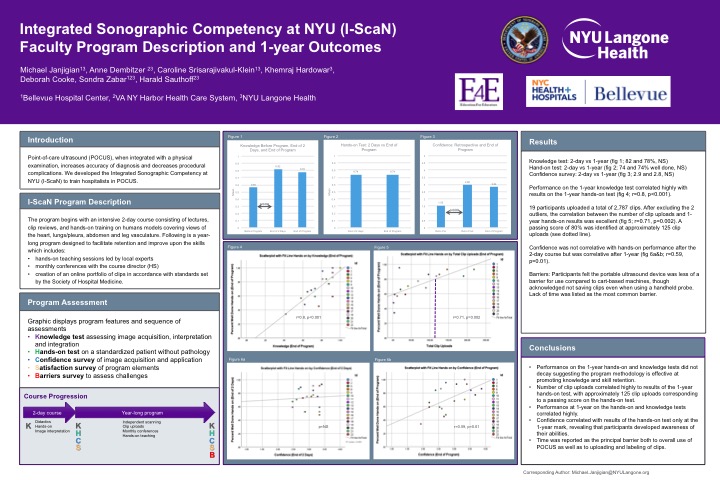Background: Point-of-care ultrasound (POCUS), when integrated with a physical examination, increases accuracy of diagnosis and decreases procedural complications.
Purpose: We developed the Integrated Sonographic Competency at NYU (I-ScaN) to train hospitalists in POCUS.
Description: The program begins with an intensive 2-day course consisting of lectures, clip reviews, and hands-on training on humans models covering views of the heart, lungs/pleura, abdomen and leg vasculature. Following is a year-long program designed to facilitate retention and improve upon the skills which includes:- hands-on teaching sessions led by local experts – monthly conferences with the course director (HS) – creation of an online portfolio of clips in accordance with standards set by the Society of Hospital Medicine.Graphic displays program features and sequence of assessments- Knowledge test assessing image acquisition, interpretation and integration – Hands-on test on a standardized patient without pathology- Confidence survey of image acquisition and application- Satisfaction survey of program elements- Barriers survey to assess challengesResults:Knowledge test: 2-day vs 1-year (fig 1; 82 and 78%, NS)Hand-on test: 2-day vs 1-year (fig 2; 74 and 74% well done, NS)Confidence survey: 2-day vs 1-year (fig 3; 2.9 and 2.8, NS)Performance on the 1-year knowledge test correlated highly with results on the 1-year hands-on test (fig 4; r=0.8, p<0.001).19 participants uploaded a total of 2,787 clips. After excluding the 2 outliers, the correlation between the number of clip uploads and 1-year hands-on results was excellent (fig 5; r=0.71, p=0.002). A passing score of 80% was identified at approximately 125 clip uploads (see dotted line).Confidence was not correlative with hands-on performance after the 2-day course but was correlative after 1-year (fig 6a&b; r=0.59, p=0.01).Barriers: Participants felt the portable ultrasound device was less of a barrier for use compared to cart-based machines, though acknowledged not saving clips even when using a handheld probe. Lack of time was listed as the most common barrier.
Conclusions: Performance on the 1-year hands-on and knowledge tests did not decay suggesting the program methodology is effective at promoting knowledge and skill retention.Number of clip uploads correlated highly to results of the 1-year hands-on test, with approximately 125 clip uploads corresponding to a passing score on the hands-on test.Performance at 1-year on the hands-on and knowledge tests correlated highly.Confidence correlated with results of the hands-on test only at the 1-year mark, revealing that participants developed awareness of their abilities.Time was reported as the principal barrier both to overall use of POCUS as well as to uploading and labeling of clips.

